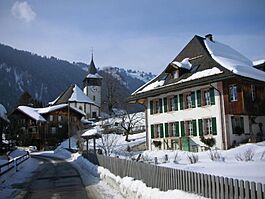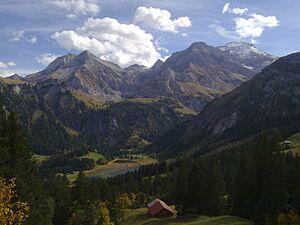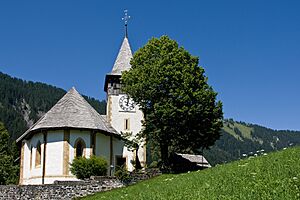Lauenen facts for kids
Quick facts for kids
Lauenen
|
||
|---|---|---|

Lauenen village and church
|
||
|
||
| Country | Switzerland | |
| Canton | Bern | |
| District | Obersimmental-Saanen | |
| Area | ||
| • Total | 58.49 km2 (22.58 sq mi) | |
| Elevation | 1,252 m (4,108 ft) | |
| Population
(Dec 2020 )
|
||
| • Total | 828 | |
| • Density | 14.156/km2 (36.665/sq mi) | |
| Postal code |
3782
|
|
| Surrounded by | Saanen, Lenk, Ayent, Savièse, Gsteig bei Gstaad. | |
Lauenen is a charming village and municipality in the Canton of Bern, Switzerland. It's located in the beautiful Obersimmental-Saanen area. The name Lauenen comes from an old German word for "landslide," which makes sense because the area is known for its mountains and sometimes, landslides or avalanches.
Contents
History of Lauenen
Lauenen was first mentioned in official records in 1296. Its name, Lowinon, is related to the German word Lawine, meaning "landslide" or "avalanche." This shows that the area has always been known for its steep, snowy slopes.
Scientists have found a Bronze Age artifact in the area, which means people lived here a very long time ago. Roman coins were also discovered near the village church and on the Wildhorn mountain.
For many years, Lauenen was part of the larger municipality of Saanen. But after a lot of discussion, Lauenen became its own independent church parish in 1522. They finished building their own parish church in 1524.
When the city of Bern decided to follow the Protestant Reformation in 1528, Lauenen wanted to stick with the old Catholic faith. However, by 1556, the Reformation was finally introduced to this mountain village, and they changed their religion.
Traditionally, people in Lauenen made a living by farming in the valley and raising cattle in seasonal alpine camps high up in the mountains.
In the 1800s, the nearby town of Gstaad became a famous place for tourists. As more visitors came to Gstaad, Lauenen also became a popular spot. The village grew richer, and many of the beautiful, decorated houses you see today were built with money from the tourist industry. In the 1970s, many visitors started buying vacation homes and chalets in Lauenen.
Geography and Nature
Lauenen covers an area of about 58.7 square kilometers (22.7 square miles). A large part of this land, about 38.1%, is used for farming. Forests cover another 25% of the area.
The village itself, along with roads and buildings, takes up about 1.3% of the land. Rivers and lakes make up 1.0%, and the remaining 34.6% is unproductive land, like rocky areas or glaciers.
Lauenen is located in the beautiful Bernese Oberland region, specifically in the Lauenen Valley. The tall mountains to the south, like Wildhorn (which is 3,243 meters or 10,640 feet high), form the border with the canton of Valais.
The municipality is home to several impressive glaciers, including the Tungel Glacier and the Gelten Glacier. It also has beautiful lakes, such as Lake Lauenen. The area includes the main village of Lauenen and several smaller, scattered communities.
Lauenen's Coat of Arms
The coat of arms for Lauenen shows a crane bird rising up, with a golden beak and legs. It stands on three green hills. Next to it, there's a golden key on a blue background. This design represents the municipality.
Population and People
Lauenen has a population of 828 people as of as of December 2020[update]. About 11.8% of the people living here are from other countries.
Most people in Lauenen speak German as their main language, about 93.5%. Albanian is the second most common language, followed by French.
In 2008, the population was almost evenly split between men and women. About 63% of the people living in Lauenen in 2000 were also born there.
The population of Lauenen has changed over time, as you can see in the chart below:

Important Heritage Sites
The old farm house and mill at Dorf 247 is a very important building. It is listed as a Swiss heritage site of national significance. This means it's a special place that helps tell the story of Switzerland's past.
Economy and Jobs
In Lauenen, many people work in different areas. In 2008, there were 346 people working in the municipality.
- About 179 people worked in the primary economic sector. This includes jobs like farming and forestry.
- Around 69 people worked in the secondary sector, which includes manufacturing and construction.
- About 98 people worked in the tertiary sector. This involves jobs in services, like hotels, restaurants, and shops.
Many people who live in Lauenen also work there. In 2000, 259 workers both lived and worked in the municipality. Some people travel to other towns for work, and some travel into Lauenen. About 52.8% of workers use a private car to get to their jobs.
Religion in Lauenen
According to the 2000 census, most people in Lauenen, about 81.5%, belonged to the Swiss Reformed Church. About 5.9% were Roman Catholic. There were also people who belonged to other Christian churches or were Muslim. A small number of people said they had no religion.
Education System
In Lauenen, about half of the adults have completed non-mandatory upper secondary education. This means they went to school beyond what is required by law. About 11.1% have gone on to higher education, like a university.
The school system in the Canton of Bern starts with one year of optional Kindergarten. After that, students go to six years of Primary school. Then, they attend three years of lower Secondary school, where they are grouped by their abilities. After lower Secondary, students can choose to continue their education or start an apprenticeship to learn a trade.
During the 2011–12 school year, there were 64 students attending classes in Lauenen. There was one kindergarten class with 11 students. The municipality had two primary classes with 42 students. There was also one lower secondary class with 11 students.
Famous People from Lauenen
- Gottfried Strasser (1854–1912) was a minister and poet who was born in Lauenen.
- Ernst Friedrich Langhans (1829–1880) worked as a reformed minister in Lauenen from 1855 to 1858.
- Anna von Wattenwyl (1841-1927) was a religious worker and officer of The Salvation Army.
See also
 In Spanish: Lauenen para niños
In Spanish: Lauenen para niños







